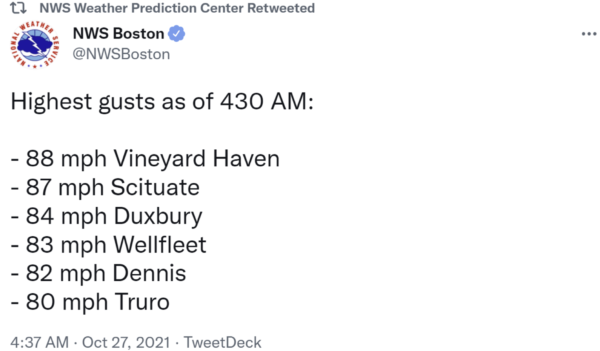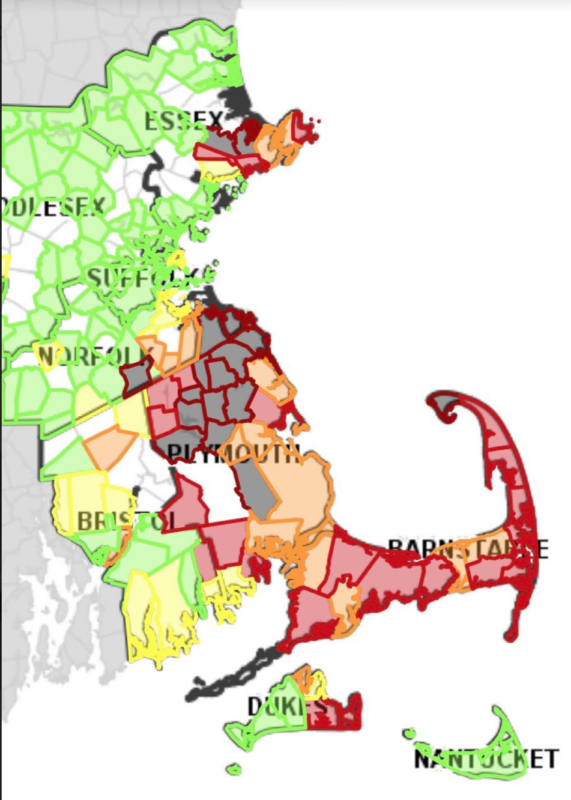Wind events affect solar power projects. Case in point: Here in New England, at least one solar power project felt the effects of a major wind event in late October.
On the night of October 26 and into the morning of October 27, New England experienced a Nor’easter weather event, the season’s first.
Gusts across the eastern coast of Massachusetts topped hurricane strength and hit 80 miles per hour in many places, including a peak gust of 94 miles per hour at 4:31 am.

According to utility companies, more than 500,000 electricity accounts lost power in the Bay State during the storm. Those accounts were concentrated on the Atlantic Coast, with large swaths of the region showing 50-100% of accounts without power from the Cape Cop region to just south of Boston.
Each account represents one electric meter, which typically supplies power to several or more people. In the adjacent map, black represents 90-100% of accounts without power, red is 50-90%, and brown/orange is 20-50% without power.

While supporting one of our electrician’s operations and maintenance contracts, my team and I were asked to visit a site within a heavily impacted wind region. A segment of the project was signaling that strings of solar panels were not connected to the inverter.
Upon arrival, we found multiple, distantly located rows of solar panels were flipped, and at least one solar panel flew 100 feet from its original location.
Additionally, an edge of the thermoplastic polyolefin (TPO) roof, which had been securely nailed to sides and edges of the building on its north and northeast sides, had been torn away and flipped over the edges of the building back onto the roof.
And, a sinister looking 60-foot line of nails pointed up through the layers of TPO.
In total, fewer than 40 of the 4,000 solar panels were affected. The electrical and mechanical teams were able to take pictures of the affected hardware, move them back to their original positions, reattach all components, and fully repower the system. Ongoing testing will determine if any solar panels will need to be replaced.
Happily, it does seem that only minimal damage occurred.
A few miles away, this author’s team was installing around 186 kW of solar panels on a very exposed rooftop. The hardware — solar panels, racking components, and ballast blocks — all was palletized and thus very heavy. Other than a garbage can used by the electrical team, none of the hardware shifted.
Three events
Arguably, three separate events occurred on the site. The first two occurred to two different rows of solar panels located in fundamentally different wind risk areas of the project. The third event affected the roofing material, which was torn up along the corner of the building and was located away from the affected rows of panels.
This author was not the developer of the project and doesn’t know the specific wind code this project was designed for. But regional wind codes in the area have a minimum of 110 mile per hour uplift requirements. The peak winds measured in this area were in the 80 to 90 miles per hour range.

Unaffected hardware on a project rooftop during the October Nor’easter. Image: Commercial Solar Guy
One could speculate that since the wind tore the roofing material upward from the northeast corner of the structure, and that the building itself sits among several other large industrial buildings, then perhaps a complex interaction between southwestern blowing storm winds greatly increased as they were bent upward by the immovable, 1800s-era multiple story brick structure.
What to look for
The main thing to look for in a ballasted solar power installation is to understand if the proper amount of ballast has been deployed. This ballast — literally engineered bricks of a certain weight — is what holds the solar power project down against winds. The racking company will do a wind analysis based on site feedback from the solar developer and engineering teams, and specify via a professional engineer-stamped drawing the weight of the ballast that must be used.
After the Nor-easter and while walking the site where the damage occurred, I saw that every solar panel and racking piece had multiple pieces of ballast in place. My quick observation did not provide enough information, however, to know if enough ballast was there.
If it turns out there was enough ballast in place for a standard roof analysis, then it may just be that a standard roofing analysis wasn’t enough. For example, I have never seen a multi-building air flow wind analysis on any projects my company has built for commercial and industrial rooftop customers.
As we increasingly build in environments where complex winds blow, we may well need to step up our engineering and design practices.






